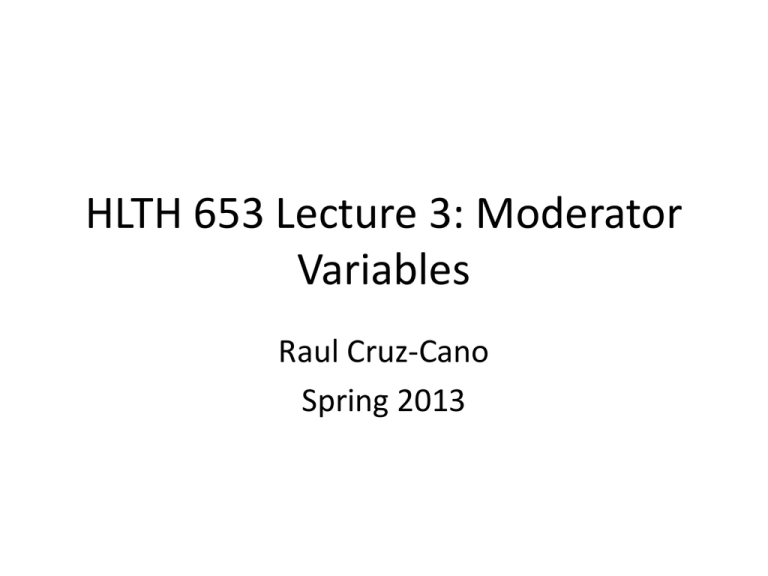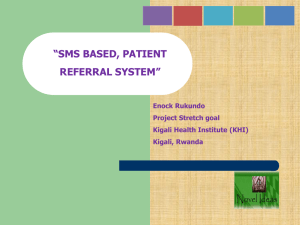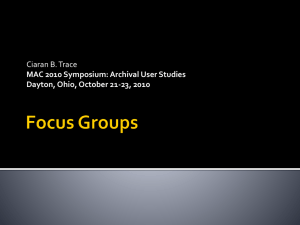
HLTH 653 Lecture 3: Moderator
Variables
Raul Cruz-Cano
Spring 2013
HW#1
• Different datasets
• P-values
• Correlation: High level vs. Significant
Moderator
•
•
A moderator is a variable that influences the strength or the direction of a
relationship between a predictor variable and a criterion variable.
In general terms, a moderator is a qualitative (e.g., sex, race, class) or quantitative
(e.g., level of reward) variable that affects the direction and/or strength of the
relation between an independent or predictor variable and a dependent or
criterion variable.
Moderator
Predictor
a
b
Predictor
Outcome
moderators and predictors are at the same
level in regard to their role as causal variables
Moderator
c
Predictor *
Interactor
Outcome
Moderator: Example
•
•
•
Suppose a researcher finds that familial stress (e.g., in the context of a child’s chronic
illness) is negatively associated with child psychological adjustment.
Although this finding may be of interest to the researcher, it may be that the effect
becomes more or less robust in the presence of other contextual variables.
In fact, the researcher may develop specific theories about conditions that determine
the strength of the relationship between stress and adjustment.
– For example, the strength or the direction of the relationship between stress and adjustment
may depend on the type of coping used by the family.
– That is, a significant association may emerge only when a child copes in a maladaptive
manner.
– By testing coping style as a moderator of the relationship between stress and outcome, the
researcher can specify certain conditions under which family stress predicts child adjustment.
– This would not only allow for more precise conclusions, but would likely have implications for
future interventions.
Moderator: Example
– For example, the strength or the direction of the relationship between stress and adjustment
may depend on the type of coping used by the family.
Coping Style
Family
Stress
Child
Adjustment
Example: Quittner, 1992
•
•
•
•
Study the role of social support in the relationship between parenting-related
stress and psychological distress in parents of children with hearing impairment
and seizure disorder.
Parenting stress is more likely to have adverse effects on adjustment when parents
have low levels of social support (i.e., social support is a moderator)?
Quittner found that the relationship between parental stress and psychological
distress did not vary as a function of level of social support.
Put another way, social support did not moderate or alter the strength or direction
of the relationship between parental stress and psychological distress.
Social Support
Parenting Stress
Psychological Distress
in Parents
Example: Stem, McCants and Pettine (1982)
• Found that the positivity of the relation between
changing life events and severity of illness was
considerably stronger for uncontrollable events
(e.g., death of a spouse) than for controllable
events (e.g., divorce).
“Controlability“
of Event
life-event change
likelihood of illness
Test for Moderator Hypotesis
Glass and Singer's (1972)
Predictor: Noise Level
Moderator:
Periodic-Aperiodic
noise
Predictor x
Interactor
a
b
Task Performance
c
Test for Moderator Hypothesis
• The model diagrammed has three causal paths:
– The impact of the noise intensity as a predictor (Path a),
– The impact of controllability as a moderator (Path b), and
– The interaction or product of these two (Path c).
• The moderator hypothesis is supported if:
1.
2.
3.
the interaction (Path c) is significant to predict the outcome or
significantly correlated with it
the moderator variable is uncorrelated with the predictor
the moderator variable is uncorrelated with the criterion (the
dependent variable)
• There may also be significant main effects for the predictor and the
moderator (Paths a and b), but these are not directly relevant
conceptually to testing the moderator hypothesis.
What does it mean if condition 2 is not met? What does it mean if condition 3 is
not met?
SAS Example 1: Rural Women HIV Study
• The cross-sectional data were collected in the first of three interviews of a
longitudinal study designed to test the efficacy of a peer counseling
intervention designed for rural women with HIV disease.
• Tested a peer-based social support intervention designed for a population
of rural women with HIV disease
• The 280 study participants were recruited from 10 community-based
HIV/AIDS service organization serving rural areas of the southeastern
United States.
• Study participants were randomly assigned to intervention and control
groups.
• Intervention group participants received a total of 12 face-to-face peercounseling sessions over a period of six months, while the control group
received the usual care provided by the agency by which they were
recruited.
• Peer counselors were recruited at each local study site to implement the
intervention.
SAS Example1: Rural Women HIV Study
• Tavakoli, A., Jackson, K., & Moneyham, L. (2009)
• The moderator effect was examined.
• The regression model included
–
–
–
–
Reason Missing of Medication (Outcome Variable)
Available social support (Predictor=Path a)
Spiritual activities (Mediator=Path b)
Their interaction effect (Interaction=Path c)
• A moderator effect exist if the interaction term
explains a statistically significant amount of
variance of criterion variable.
SAS Example1: Rural Women HIV Study
• Variables:
–
–
–
–
Available Social Support (TSSQAV)
Spiritual Activities (TCOPESA)
Reason Missing of Medication (TREAS)
Interaction (SSCOPESA)
Title ' Regression model / testing moderator effect' ;
proc reg data=two;
model treas = tssqav tcopesa sscopesa/ stb pcorr2 scorr2;
run;
STB: displays standardized parameter estimates
PCORR2: displays squared partial correlation coefficients computed using Type II sums of squares
SCORR2 : displays squared semipartial correlation coefficients computed using Type II sums of squares
SAS Example1: Rural Women HIV Study
SAS Example1: Rural Women HIV
Study
• The result did not reveal any moderator effect
for available social support and spiritual
activities (P-value=0.51), i.e. condition 1 was
not met
SAS Example 2: Moderator Effect for Social Support
of Mothers of Mentally Ill Children
• Tavakoli, Scharer & Hussey, L. (2011)
• This study examines the role of perceived stress in the relationship
between social support and mood, and tested if moderator effects
influenced the relationship.
• The role of coping in the relationship between perceived stress and
mood was also examined for potential moderator effects.
• The cross-sectional data reported here were collected in an
experimental design with repeated measures with mothers of
children who had been hospitalized on a child psychiatric unit.
• A convenience sample of mothers was randomly assigned into
three groups: A web-based intervention group, a telephone social
support intervention group, and a usual care group.
• The moderator effect was examined by including interaction effect
in the regression model.
SAS Example 2: Moderator Effect for Social
Support of Mothers of Mentally Ill Children
• Variables: Perceived stress (TPSS) as moderator of
social support (TSS) to mood (POMSMOD)
• TPSSSS= Interaction
proc reg data=two;
model pomsmod = tpss tss tpssss / stb pcorr2 scorr2;
run;
SAS Example 2: Moderator Effect for Social
Support of Mothers of Mentally Ill Children
SAS Example 2: Moderator Effect for Social
Support of Mothers of Mentally Ill Children
• The result did not reveal any moderator effect
for social support and perceived stress (Pvalue=0.4878), i.e. condition 1 was not met
SAS Example 2: Moderator Effect for Social
Support of Mothers of Mentally Ill Children
• Variables: Coping (TCOPE) as moderator
perceived stress (TPSS) to mood (POMSMOD)
• TPSSCOP = Interaction
proc reg data=two;
model pomsmod = tcope tpss tpsscop / stb pcorr2 scorr2;
run;
SAS Example 2: Moderator Effect for Social
Support of Mothers of Mentally Ill Children
SAS Example 2: Moderator Effect for Social
Support of Mothers of Mentally Ill Children
• The result did not indicate any moderator
effect for perceived stress and coping (Pvalue=0.1004), condition 1 was not met
SAS Example 3: Attitudes About Animals
• Ethical idealism as a dichotomous moderator variable
• Dichotomy was produced by classifying cases with idealism scores
greater than the median as being “idealistic” and those with scores
less than or equal to the median as being “nonidealistic.”
• The attitude towards animal rights and animal research scale used
consisted of 28 items
• Item-total correlations were good, in other words, these 28 items
were internally consistent, all measuring the same basic construct.
One containing items reflecting concern with the violation of animal
rights by using animals for food, clothing, and fur (AR=Support of
Animal Rights).
• Misanthropy is the general hatred, mistrust or disdain of the human
species or human nature.
SAS Example 3: Attitudes About Animals
• Hypothesized that misanthropy would be less
strongly related to support for animal rights
among idealists
Idealism
Misanthropy
Support of Animal Rights
Run Moderate.sas
SAS Example 3: Attitudes About Animals
• Moderator variable, idealism, is not significantly
related to either misanthropy or support of animal
rights.
– Correlation between Idealism and AR = 0.03
– Correlation between Idealism and Misanthropy = -0.14
– Conditions 2 and 3=
• While ethical idealism may not be related to support of
animal rights here, it may moderate the relationship
between misanthropy and support of animal rights.
– Condition 1= ?
SAS Example 3: Attitudes About Animals
ZAR =.303ZMisanth + .067ZIdeal .146 Zinteraction -.02
Model:
• R-Square =0.1130
• p-value=0.0004
p = .049
All this evidence indicates that ethical idealism does function as a moderator of the
relationship between misanthropy and support of animal rights
Who moderates who?
• Remember a lot is based on correlations,
hence causality is kind of tricky….
Other options
• Subgroup analysis: In subgroup analysis, to identify the moderator
variable, the sample is split into subgroups on the basis of the third
variable. In this method, to identify the moderator variable, regression
analysis is employed to investigate the relationship between the
predicator variable and the criterion of each subgroup variable. R2
measures the presence or absence of the moderator variable.
• Moderated regression analysis (MRA): This is a regression based
technique that is used to identify the moderator variable.
(1)
(2)
(3)
Z=Moderator
Other Cases
1. Moderator continuous, independent
continuous, dependent continuous =>We just
studied
2. Moderator dichotomous, independent
dichotomous, dependent continuous => 2x2
ANOVA (with interaction term) for condition
1, one-way ANOVA for conditions 2 and 3
PROC ANOVA DATA = dental;
class A B;
model relief = A B A*B;
RUN;
Other Cases
3. Moderator is a dichotomy, independent
variable is a continuous, dependent
continuous => conditions 2 and 3 the same as
in class, for condition 1: correlate
independent variable with outcome variable
separately for each value of the moderator
and then test the difference
Other Cases
4. Moderator is a continuous variable, the
independent variable is a dichotomy =>Depends
on the effect
Reuben M. Baron and David A. Kenny, The
Moderator-Mediator Variable Distinction in
Social Psychological
Research: Conceptual, Strategic, and
Statistical Considerations,
Journal of Personality and Social Psychology,
1986, Vol. 51, No. 6, 1173-1182
Dichotomous DV
• What if the DV is dichotomous (e.g., group
membership, voting decision etc.)?
• Use moderated logistic regression (Jaccard, 2001)
Logit ( ) b 0 b 1 X b 2 M b 3 X M
In summary…
Continuous DV
Dichotomous DV
moderated logistic
regression
Independent
Continuous
Dichotomous
Moderator
Continuous
Dichotomous
Class #1
#3
#4
#2
References
•
•
•
•
•
•
•
Quittner, AL. Re-examining research on stress and social support: the importance of contextual
factors. In: La Greca AM, Siegel LJ, Wallander JL, Walker CE, eds. Stress and Coping in Child Health.
New York: Guilford Press; 1992:85– 115.
Stern, G. S., McCants, T. R., & Pettine, P. W. (1982). The relative contribution of controllable and
uncontrollable life events to stress and illness. Personality and Social Psychology Bulletin, 8, 140145.
Glass, D., & Singer, J. (1972). Urban stress: Experiments on noise and social stressors. New York:
Academic Press.
Tavakoli, A., Jackson, K., & Moneyham, L. (2009). Examining Mediator and Moderator effect using
Rural Women HIV Study. SAS Global Forum. March 21-25, Washington DC.
Abbas S. Tavakoli, DrPH, MPH, ME; Kathleen Scharer, PhD, RN, PMHCNS-BC, FAAN; & Jim Hussey,
PhD, Compare Imputation and no Imputation to Examine Mediator Effect for Social Support of
Mothers of Mentally Ill Children , SAS Global Forum 2011
Wuensch, K. L., Jenkins, K. W., & Poteat, G. M. (2002). Misanthropy, idealism, and attitudes towards
animals. Anthrozoös, 15, 139-149.
James Jaccard , Interaction Effects in Logistic Regression, Issue 135, Quantitative Applications in the
Social Sciences, Volume 135 of A Sage university paper, Sage university papers series. no. 07-135,
Issue 7, Part 135 of Sage university papers series: Quantitative applications in the social sciences
Interaction Effects in Logistic Regression, Interaction Effects in Logistic Regression







